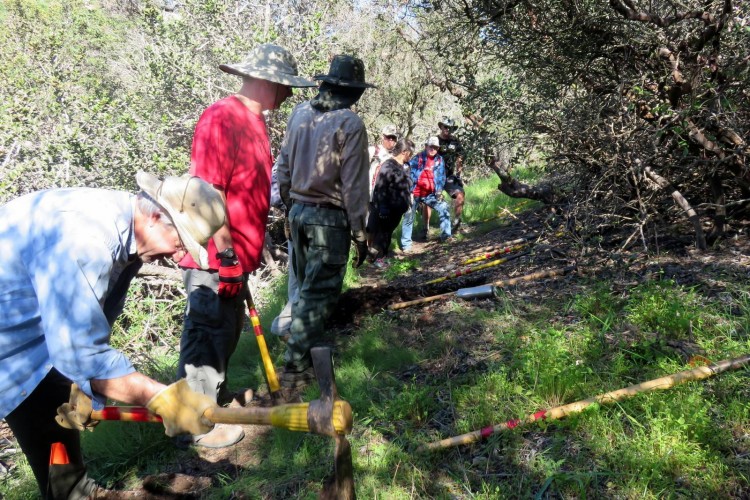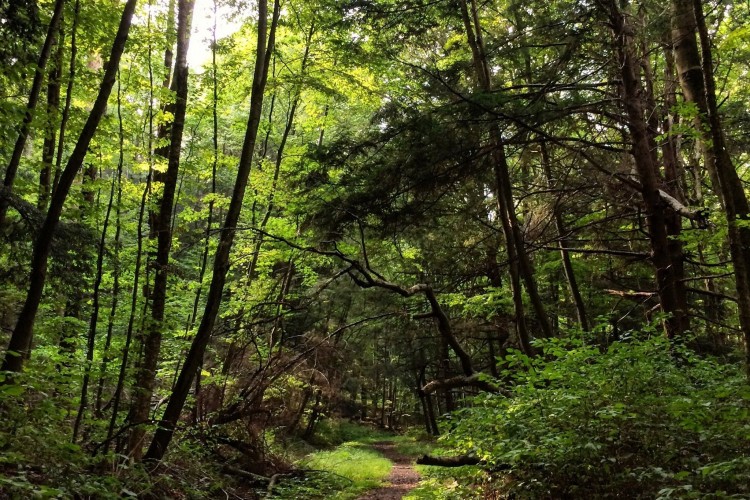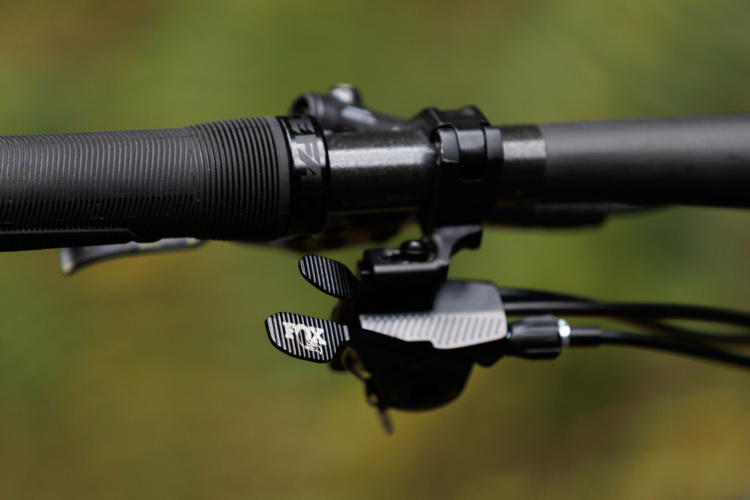We’ve received several emails from IMBA urging mountain bikers to respond to the USFS’s request for comments regarding “Nantahala and Pisgah National Forests Potential Wilderness Inventory.” From the initial emails, it sounded like IMBA wanted riders to comment regarding the simple inventorying of land–but they didn’t really explain what all the hubbub was about, and which trails could potentially be affected.
So I did some digging.

Click here to see which areas the Forest Service is planning to inventory.
To many people, the shaded colors on the map linked above just look like ambiguous lines on a map, and the default zoom is pretty far out, so you may not know exactly how much land is being inventoried. But for someone familiar with the area, after looking at this map, you quickly realize that some of the best mountain biking areas in Western North Carolina will be inventoried to evaluate their wilderness nature.
I’ve analyzed the inventory map and compared it to our trail database and my Brevard-area Pisgah National Forest map, and popular, epic singletrack mountain bike rides that will be inventoried include, but are not limited to:
- The entire trail system in Panthertown Valley, comprising some 19+ miles of riding.
- The entire Laurel Mountain area, which includes the Laurel Mountain trail, one of the iconic Pisgah rides, along with…
- …Pilot Rock, and:
- Pilot Cove
- Pilot Cove Loop
- Little Pisgah Ridge
- Fletcher Creek Trail
- Middle Fork Trail
- Spencer Gap… and possibly more
- The entire South Mills River area, which includes a significant portion of the Black Mountain trail, one of the most revered singletrack rides in the Brevard region. Along with…
- Turkeypen Gap
- Pink Beds
- Vineyard Gap
- South Mills River
- Buckhorn Gap
- Squirrel Gap
- Horse Cove Gap
- Cantrell Creek
- Bradley Creek
- Laurel Creek
- Mullinax
- Riverside
- The Sam Knob Area, including Flat Laurel Creek…
- …and Ivestor Gap
- The Daniel Ridge Area, including the Daniel Ridge Loop…
- …and the Farlow Gap Trail
- Cove Creek
- Caney Bottom
- The Cedar Rock Mountain Area, including Cemetery Loop…
- …and Long Branch
- Davidson River Trail
- Butter Gap
- Cat Gap Loop
And of course, that doesn’t include any affected gravel roads.

Above are simply the inventory areas near and around Brevard, the area I’m most familiar with. There are a plethora of other inventory areas that include, or may include, current mountain bike trails as well.
The other inventory areas are:
- Jarrett Creek Area, home to the Glass Rock Knob trail, and others.
- The Mackey Mountain area, home to the Mackey Mountain Trail and many others.
- The Black Mountains area, which includes Mount Mitchell and would affect the famously-popular Assault on Mount Mitchell course and associated trails. For more information on trails in this area, click here and here.
- Middle Prong Area
- Woods Mountain Area
- Bearwallow Area
- Craggy Mountain Area
- Dobson Knob Area
- Linville Pinnacle Area
- Linville Gorge Area
- Harper Creek Area
- Sugar Knob Area
- Steels Creek Area
- Wilson Creek Area
- Highlands of Roan Area
- Nolichuchy Gorge Area
- Bald Mountain Area
- Bluff Mountain Area
- Pigeon River Area
- Terrapin Mountain Area
- Ellicott Rock Area
- Fishhawk Mountain Area
- Barkers Creek Area
- Big Indian Area
- Little Indian Area
- Chunky Gal Area
- Sharptop Ridge Area
- Cherry Cove Area
- Boteler Peak Area
- Tusquitee Bald Area
- Siler Bald Area
- Tellico Bald Area
- Wesser Bald Area
- Cheoah Bald Area
- Piercy Mountain Range
- Ash Cove Area
- Cantrell Top Area
- Unicoi Mountains / Upper Bald River Area
- Snowbird Area
- Santeetlah Headwaters Area
- Joyce Kilmer Slickrock Area
- Deep Creek / Avery Creek Area
- Yellowhammer Branch Area
- Yellow Creek Mountains

I’ve outlined in detail the trails in the areas that I’m most familiar with but please, if you’re more familiar with the areas on the second list than I am and the trails that these areas affect, please mention them in the comments section below.
Now, it’s worth noting that even if the Forest Service inventories these trails for possible Wilderness inclusion, that they’re not guaranteed to become wilderness. Rather, the Forest Service will begin by:
- “Identifying and inventorying all lands that may be suitable for inclusion in the National Wilderness Preservation System”
- “Evaluating the wilderness characteristics of each area based on a given set of criteria”
- “Determining which areas to further analyze in the National Environmental Policy Act process”
- “Deciding which areas, if any, to include in the National Wilderness Preservation System”
So granted, this is step one in the process, but as you can see from the list of trails and areas outlined above, this inventory is far-reaching and could potentially be devastating to the mountain biking community in Western North Carolina–and consequently, due to the epic nature of this mountain bike destination, the global mountain biking community as well.
As Vernon Felton astutely commented in his recent article, this inventory is dangerous because:
“The Forest Service. . .has taken a new, hardline stance against mountain bikes, closing hundreds of miles of trails to mountain bikers not because those trails lie in Wilderness areas, but because they might one day–maybe decades from now–be considered for possible Wilderness designation.”
Let us take action now to prevent the possible loss of these most epic MTB rides!

Appeal for Comments
Here’s IMBA’s appeal for comments in its entirety, to give you the information you need to submit comments:
As part of their forest plan revision process, the Nantahala and Pisgah National Forests are seeking public input to their current inventory of lands that may be suitable for Wilderness. The current comment period for Wild and Scenic Rivers and Potential Wilderness Areas extends through December 15th.
This is the “first cut” from the Forest Service, and determined by set criteria set by the National Forest Planning Rule. At this time the Forest Service is seeking responses to evaluation questions, not preference of management for an area or general opinions on wilderness vs. non-wilderness.
Submitted comments should closely follow the Forest Service’s evaluation form. The evaluation form is long and it would be cumbersome to fill out one for each area. The Forest Service has indicated they will also consider comments that are submitted independent of the evaluation forms, but these comments must refer to specific evaluation criteria, and not be general in nature.
Please note that the potential wilderness inventory has increased since the last fall due to changes in the Forest Management Plan directives. Please check the additions. Areas added to the inventory can be found in the following PDF document: Nantahala and Pisgah National Forests Process Paper.
How To Make Comments
There are two ways you can submit comments at this time. We strongly urge you tosubmit comments BEFORE DECEMBER 15, 2015 for consideration.
-
The following link will take you to all information you need to fill out evaluation forms in their entirety for any or all of the potential wilderness areas: Inventory and Evaluation Process of Lands that may be Suitable for Wilderness. This resource has an introduction, web map (“Inventory” tab), and instructions for sharing your thoughts on the areas in the inventory.
-
If you do not want to use the above resource to comment on each individual area you can send general comments to the forest service at: [email protected] or on this page by submitting your comments using the form below. IMPORTANT: Your comments should follow the format that the Forest Service has requested on their form. Relevant sections of this form are outlined below for your information. To more easily make comment, copy the areas in bold into your e-mail and add the proposed wilderness areas which apply. A form to submit comments is at end of this post.
Environmental Coalition Press Release
Since I began writing this article, a coalition of 30 conservation and recreation advocacy organizations have released an Memorandum of Understanding (MOU) detailing their recommendations to the USFS. Included on the MOU are IMBA, Nantahala SORBA, Pisgah Area SORBA, and other mountain biking organizations.
Here is the source of the document, and here is the MOU in its entirety:
(SYLVA, NC)—A coalition of conservation and recreation organizations recommends more trails and better public access as well as backcountry and wild areas for the Nantahala-Pisgah National Forest, according to a Memorandum of Understanding (MOU) developed by the coalition. The coalition is submitting the MOU to the U.S. Forest Service as part of the ongoing forest plan revision process for the Nantahala-Pisgah National Forests.
The coalition includes Access Fund, American Alpine Club, American Whitewater, Back Country Horsemen of America, Back Country Horsemen of Blue Ridge, Back Country Horsemen of North Carolina, Back Country Horsemen of Pisgah, Back Country Horsemen of Western North Carolina, Black Dome Mountain Sports, Blue Ridge Outdoors Magazine, Carolina Adventure Guides, Carolina Climbers Coalition, Franklin Bird Club, Friends of Big Ivy, Ground Up Publishing, Highlands-Cashiers Land Trust, Highlands Plateau Audubon Society, Hiwassee River Watershed Coalition, International Mountain Biking Association (IMBA), MountainTrue, Nantahala Area Southern Off-Road Biking Association (SORBA), Nantahala Hiking Club, North Carolina Horse Council, Northwest North Carolina Mountain Bike Alliance, Outdoor 76, Outdoor Alliance, Pisgah Area SORBA, Pisgah Mountain Bike Adventures, Southern Appalachian Plant Society, Southern Appalachian Wilderness Stewards (SAWS), Stay and Play in the Smokies, The Wilderness Society, Trout Unlimited – Unaka Chapter, and Wild South.
The idea driving the coalition is simple:Western North Carolina’s national forests are the region’s greatest public asset, and should be protected for their inherent beauty, biodiversity, and their many values. Recognizing that Nantahala-Pisgah National Forest is in the top three most visited national forests in the United States, the proposal acknowledges the economic importance of these forests for recreation and tourism, and recommends management of these assets in a responsible manner that is both environmentally and economically sound. The management and designations proposed by the coalition extend stronger protections to more than 365,000 of the national forest’s nearly 1.1 million acres including two new National Recreation Areas and more than 109,000 acres of recommended wilderness.
Key recommendations within the proposal:
° Two new National Recreation Areas for Western North Carolina: a 115,573-acre Pisgah National Recreation Area and a 57,400-acre Grandfather National Recreation Area that will protect these areas from resource extraction and ensure that their unique natural beauty and ecological diversity are maintained for future generations, while recreation use such as hiking, mountain biking, horseback riding, hunting, fishing, kayaking, and climbing is planned and managed for as a long-term priority. National Recreation Areas will formalize recreation access in key points of our forests, and would allow for the establishment of sustainable infrastructure to prevent damage to the areas while preserving recreational opportunities.
° Wilderness protection for 109,961 acres in the Nantahala-Pisgah National Forests. Hunting, fishing, horseback riding, and hiking are among the many activities that would be welcomed in these areas. While the Forest Service can recommend wilderness, it would have to be approved by Congressional legislation and signed into law by the president.
Those who support the recommendations put forth in the MOU can help by providing public comments to the Forest Service that both endorses a plan that provides more public access and recreation, and protects more of our backcountry and wild places.
Comments can be submitted via email at [email protected] or via mail at United States Forest Service Supervisor’s Office, 160 Zillicoa St, Suite A, Asheville, NC 28801.
While this is encouraging, especially since Pisgah Area SORBA is on board, we all know following the Boulder White Clouds debacle that even if other non-wilderness designations, such as a National Monument or a National Recreation Area, seem like they’ll be passed with almost complete certainty, the tides can change at the last minute.
Also, while it’s good to see mountain advocacy groups involved, the MOU doesn’t specify what land and trails the National Recreation Areas will contain, and what areas the additional 109,961 acres of Wilderness Areas will consist of. If you have additional information on the borders of these proposed areas, please be sure to leave a comment below.
Please be sure to still submit comments proclaiming your desire to continue mountain biking in these areas!
Also, please consider donating to the Sustainable Trails Coalition to help further their efforts to open some Wilderness Areas and trails to mountain bikes.
Update 12/10/2015, 2:24pm MST:
Here’s more information from IMBA about the official IMBA-SORBA position, and where they propose that the National Recreation Areas be created, and where the Wilderness expansions should happen:
The IMBA-SORBA position is as follows:
1. IMBA-SORBA does not support USFS timber production in areas of the forest with heavy recreational use, including the Pisgah District—particularly in the Davidson River and South Mills River areas. Timber production in these areas could negatively impact the backcountry mountain biking experience.
2. IMBA-SORBA does not support the proposed Wilderness designation in the Pisgah and Grandfather Districts for Daniel Ridge, Laurel Mountain, Cedar Rock Mountain, South Mills River, Woods Mountain and Jarrett areas. These areas have a high concentration of trails and are heavily used for recreation, including mountain biking.
3. IMBA-SORBA requests that the USFS include the above-mentioned areas in a new National Recreation Area, which would provide the land maximum protection while still allowing mountain biking.
4. IMBA-SORBA also supports a National Recreation Area designation in the Grandfather District that would include Harper’s Creek, Lost Cove, Woods Mountain and Jarret Creek.
5. IMBA-SORBA supports some of the Wilderness proposals in areas where there is no mountain biking, and is working with conservation groups and other forest stakeholders to identify such areas.





















2 Comments
Dec 10, 2015
My takeaway is that mountain bikers need to send substantive comments about what is currently located in the study areas and how those areas are being managed. At this stage, the FS isn't looking for arguments about the impact of mountain bikes--they just want to know what the heck is in each area and whether it's worth protecting.
Funny, I would think the FS or a group of specially trained consultants would be able to carry out an inventory in a much more objective manner than "crowdsourcing" this info from the public. Hard to believe this is how the process actually works...
Dec 10, 2015
Here's more information from IMBA about the official IMBA-SORBA position, and where they propose that the National Recreation Areas be created, and where the Wilderness expansions should happen:
The IMBA-SORBA position is as follows:
1. IMBA-SORBA does not support USFS timber production in areas of the forest with heavy recreational use, including the Pisgah District—particularly in the Davidson River and South Mills River areas. Timber production in these areas could negatively impact the backcountry mountain biking experience.
2. IMBA-SORBA does not support the proposed Wilderness designation in the Pisgah and Grandfather Districts for Daniel Ridge, Laurel Mountain, Cedar Rock Mountain, South Mills River, Woods Mountain and Jarrett areas. These areas have a high concentration of trails and are heavily used for recreation, including mountain biking.
3. IMBA-SORBA requests that the USFS include the above-mentioned areas in a new National Recreation Area, which would provide the land maximum protection while still allowing mountain biking.
4. IMBA-SORBA also supports a National Recreation Area designation in the Grandfather District that would include Harper’s Creek, Lost Cove, Woods Mountain and Jarret Creek.
5. IMBA-SORBA supports some of the Wilderness proposals in areas where there is no mountain biking, and is working with conservation groups and other forest stakeholders to identify such areas.